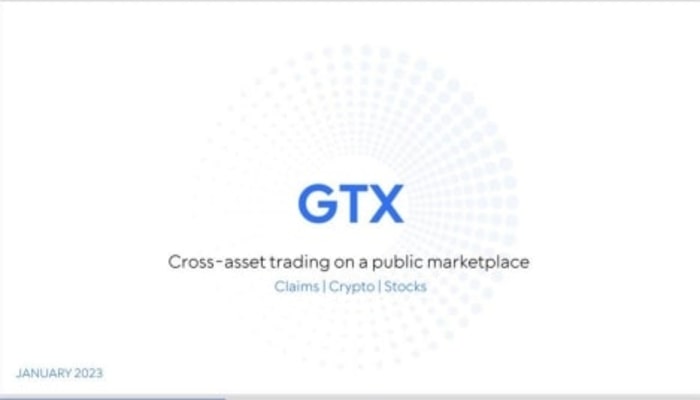Former 3AC Founders Plans To Raise $25M To Build A New Crypto Exchange
Three Arrows Capital is planning to make a comeback with the goal of raising $25 million to launch a brand-new cryptocurrency exchange that will be known as GTX.
GTX
Co-founders of the now-defunct Three Arrows Capital (3AC), Kyle Davies and Su Zhu, along with co-founders of the cryptocurrency exchange CoinFLEX, Mark Lamb and Sudhu Arumugam, are attempting to raise approximately $25 million in order to establish a new cryptocurrency exchange that will be known as GTX.

GTX Presentation Deck
According to the presentation deck, the founding team of the GTX believes that the $20 billion crypto claims market needs to trade on a public marketplace. In order to accomplish this, they plan to provide claimants the ability to “sell them to crypto while utilizing claims as margin money,” therefore, claimants will now have access to liquid assets as a result. The GTX team intends to broaden their product offering so that it will support trading in cryptocurrencies, equities, and foreign exchange.
In order to establish the exchange, GTX will utilize the technology that was built by CoinFLEX. In addition, the company is going to employ a legal counsel to oversee the onboarding of claims for all of the recently established cryptocurrency startups that have been unsuccessful, such as Celsius, BlockFi and Voyager. After its completion of the capital raising campaign, the newly established exchange plans to launch its trading operations at some point during the month of February.
GTX pitch deck
The untimely demise of Sam Bankman-Fried’s FTX empire last November shocked the cryptocurrency market in a startling turn of black swan events in 2022. In order to fill the gap left
by FTX’s demise and satisfy the appetite for crypto trading among those impacted by the implosion, a new player in the game called GTX has entered the fray.
According to GTX’s pitch deck, the platform hopes to draw not only FTX creditors but also those of other failed businesses like Celsius, BlockFi, and Voyager; as well as people who lost their assets in Mt. Gox in 2014. The market for cryptocurrency claims is enormous, with a projected range of 100,000 to over 1 million creditors for FTX alone.
By utilizing claimants’ debt capital, GTX hopes to take advantage of this market, dominate the cryptocurrency claims market within three months, and eventually become the biggest cryptocurrency exchange. The platform has ambitious plans to eventually include lending, cryptocurrency, stocks, and the foreign exchange market in its offerings.
3AC collapse refresher

Three Arrows Capital was a notable hedge fund and was a prominent player operating in the cryptocurrency industry. But when the market crisis struck and prices began to fall, 3AC’s assets were completely wiped out, and the company was compelled to petition for protection under the bankruptcy laws.
Following the collapse of the Terra ecosystem, the crypto hedge fund run by Zhu and Davies failed in June 2022. The collapse spread like wildfire throughout the cryptocurrency sector and compelled other crypto lending companies to file for bankruptcy. Unrepentant, the two co-founders have refused to cooperate with creditors and liquidators. As a result, they recently received subpoenas via Twitter from the Department of Justice in the United States and the Supreme Court of Singapore.
3AC’s failure set off a chain reaction that spread throughout the market. The now-defunct hedge fund affects a sizable number of shareholders or businesses, and all of them had to deal with a liquidity crisis.
CoinFLEX

In June 2022, CoinFLEX stopped processing withdrawals. In spite of this, the company went back to execute partial withdrawals in the following month. The crypto exchange also took legal action against a platform user in a Hong Kong court in an effort to mitigate a $84 million deficit in their balance sheet.
An investor named Roger Ver defaulted on a $47 million debt owed to CoinFLEX, which eventually increased to $84 million after his CoinFLEX account went into negative equity. CoinFLEX underwent a restructuring process as a result and the founders reportedly lost every stake they had in the business as a result of the restructuring. Leslie Lamb, who currently holds the position of CoinFLEX’s chief marketing officer, is a candidate for the same position at the new exchange.
A second chance?
Many in the cryptocurrency sector have been shocked and disturbed by the founders’ choice to seek finance for $25 million rather than take a chance on negative legal repercussions. This follows the loss of investor funds totaling more than $10 billion.
The general consensus among cryptocurrency users was unfavorable at the GTX pitch desk. People now have doubts about the possibility for the exchange to be stable, as well as how it will be different in terms of fostering openness and confidence. These concerns stem from the disclosure that was made public.
https://twitter.com/ChainLinkGod/status/1615032670416949248Moreover, because the letter “G” follows the letter “F” in the alphabet, it cannot be denied that the name exchange is similar to the name of the now-defunct FTX.
https://twitter.com/CryptoDonAlt/status/1615017610701344768Conclusion
Defunct crypto companies have failed due to a lack of understanding of the market, poor management or other factors. By starting a new business, they may be able to learn from their past mistakes and improve their chances of success. However, it is important to note that starting a new crypto business after a failure does not guarantee success.
Investing in companies that have gone bankrupt or have shut down operations in the past can be risky because it may indicate a lack of financial stability or poor management. These
companies may have struggled to make a profit or manage their finances effectively in the past, which could make it difficult for them to turn things around in the future. Defunct companies have lost the trust of customers and investors, which could make it difficult for them to regain their footing and attract new customers and investors.
It is important to conduct thorough research and due diligence to understand the reasons behind a company’s failure and the measures that have been taken to address them. This will help you to assess the risk and potential for success of investing in a company that has gone bankrupt or shut down operations in the past.











